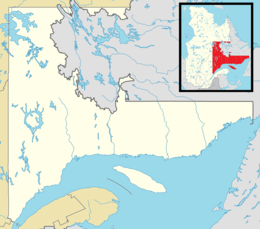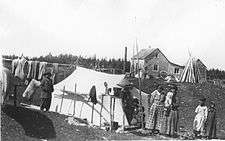Mingan, Quebec
Mingan, also known as Ekuantshit in Innu-aimun, is an Innu First Nations reserve in the Canadian province of Quebec, at the mouth of the Mingan River on Mingan Bay of the Gulf of Saint Lawrence. It belongs to the Innu band of Ekuanitshit.[1] Geographically it is within the Minganie Regional County Municipality but administratively not part of it.
Mingan | |
|---|---|
 Mingan Location in Côte-Nord region of Quebec. | |
| Coordinates: 50°18′N 64°02′W | |
| Country | |
| Province | |
| Region | Côte-Nord |
| Regional county | none |
| Formed | 1963 |
| Government | |
| • Chief | Jean-Charles Piétacho |
| • Federal riding | Manicouagan |
| • Prov. riding | Duplessis |
| Area | |
| • Total | 19.15 km2 (7.39 sq mi) |
| • Land | 16.89 km2 (6.52 sq mi) |
| Population (2006)[3] | |
| • Total | 407 |
| • Density | 24.1/km2 (62/sq mi) |
| Time zone | UTC-5 (EST) |
| • Summer (DST) | UTC-4 (EDT) |
| Postal Code | G0G 1V0 |
| Area code(s) | 418 and 581 |
The reserve is accessible via Quebec Route 138, 10 kilometers (6.2 mi) east of the village of Longue-Pointe-de-Mingan and 36 kilometers (22 mi) west of downtown Havre-Saint-Pierre. It is serviced by a health centre, community radio station, library, cultural centre, community store, municipal water and sewer system, fire station, and an aboriginal police force.[1]
The name Mingan, already appearing as mican on a map of 1631, is generally considered to originate from the Innu word maikan, meaning "timber wolf". But there is no certainty over this interpretation. It has also been proposed that it may have come from the Basque word mingain meaning "language", or the Breton term menguen that translates as "white stone".[4]
History
_LABRADOR-EXP._p516_NASQUAPEE_INDIANS_AT_THE_HUDSON'S_BAY_COMPANY'S_POST_AT_MINGAN.jpg)

Historically, the region was the homeland of the Innu people, who came there from their inland hunting grounds to spend the summer on the coast. Mingan was a summer gathering site where the Innu would fish for salmon, hunt for whale, have family meetings, and trade with each other. In 1661 the Mingan Seignory was granted and Europeans began to settle in the area, marking the beginnings of the fur trade, which continued until the early 20th century. The North West Company and then the Hudson's Bay Company (from 1807 to 1873) maintained trading posts there under the name Mingan, which were frequently visited by Innu to trade furs, although they continued to stay there during the summers only.[4][5]
The Innu's nomadic way of life was disrupted during World War II, as mining and forestry companies moved into the area. After the war, mandatory education, fluctuating fur prices, and government housing programs led the Innu to settle permanently there.[5]
On April 30, 1963, the Government of Québec transferred 7 square miles (18 km2) of land in the seignory of Mingan to the Government of Canada to establish a reserve for the Mingan region Innu. The reserve however had no access to the Mingan River, which the Innu depended on for subsistence. After many years of struggle, the river banks were added to the reserve in 1983. In 1996, it was further expanded.[5][6]
Demographics
As of December 2009, the band counted 556 members, of which 532 persons are living in the community.[1] Private dwellings occupied by usual residents amount to 120 out of a total of 209. Mother tongues spoken on the reserve are:[3]
- English as first language: 0%
- French as first language: 2.4%
- English and French as first language: 0%
- Other as first language: 97.6%
Population trend:[7]
- Population in 2006: 407 (2001 to 2006 population change: 4.1%)
- Population in 2001: 391
- Population in 1996: 431
- Population in 1991: 365
Education
There is only one school on the reserve, École Teueikan, that provides pre-Kindergarten to Secondary grade 4, and had an enrollment of 106 students in 2008–2009.[1]
See also
References
- "Ekuanitshit First Nation". Aboriginal Community profiles. Indian and Northern Affairs Canada. Archived from the original on 2011-06-13. Retrieved 2010-10-01.
- Ministère des Affaires Municipales, Régions et Occupation du territoire - Répertoire des municipalités: Mingan
- Statistics Canada 2006 Census - Mingan community profile
- "Mingan (Réserve indienne)" (in French). Commission de toponymie du Québec. Retrieved 2010-10-01.
- Harold Bherer; Sylvie Gagnon; Jacinte Roberge (1990), Wampum and letters patent: exploratory study of native entrepreneurship, IRPP, pp. 109–111, ISBN 978-0-88645-116-5
- Natural Resources Canada - Legal Surveys Division, Historical Review - Mingan land title history Archived 2011-07-06 at the Wayback Machine
- Statistics Canada: 1996, 2001, 2006 census